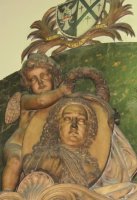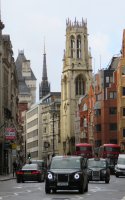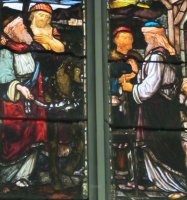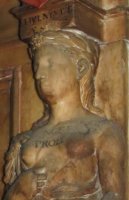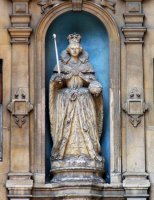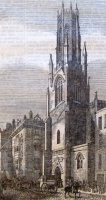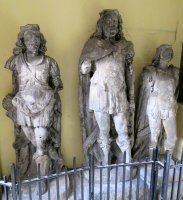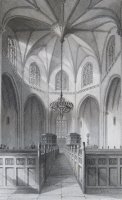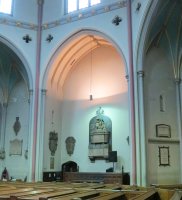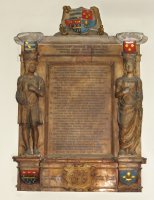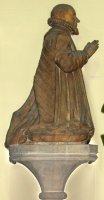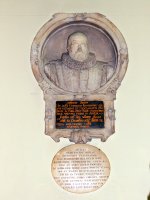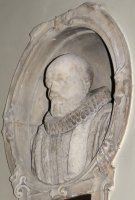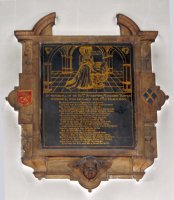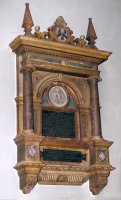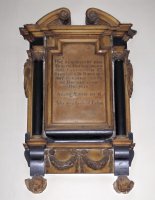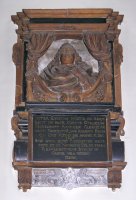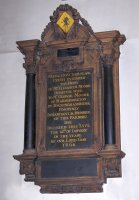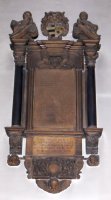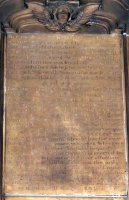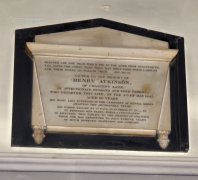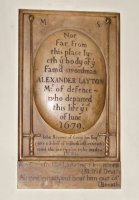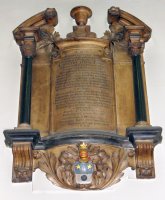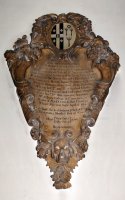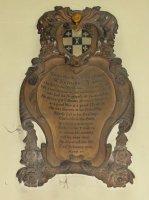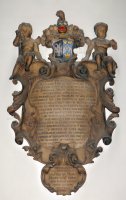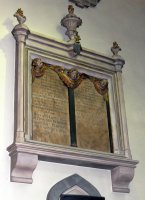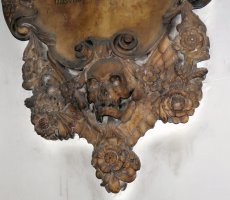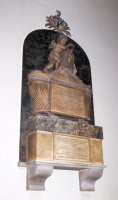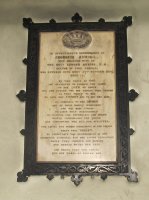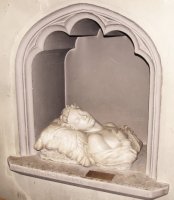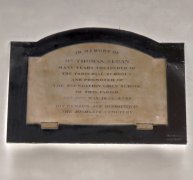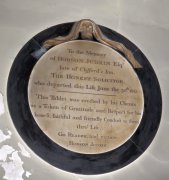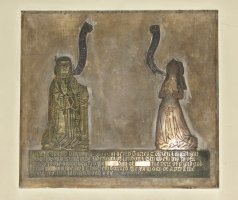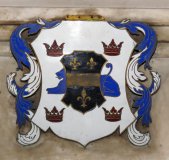St Dunstan in the West - Monuments
A 19th Century replacement for a medieval church, containing around 40 panel monuments, including much interesting carving, and including the monument to the Marshall family of sculptors.
The medieval St Dunstan in the West was first recorded in the 12th Century and considered a 'fair and beautiful church' in 1632, just missed the Fire of London and another fire in 1730, and was repaired and patched up through to as late as 1820, and then within a decade was unsentimentally pulled to widen the road.
Elizabeth I, the tower, and Northcliffe.
The new Church, to the design of the architect John Shaw, was built in 1830-1832 and consecrated the following January. The tower, around 130 ft high with the upper portion as a delicate, octagonal lantern, is made of Ketton stone, 'a very superior kind of freestone from the county of Rutland'. The frontage to the street is distinguished by the famous clock from the old church, with its bell-striking figures variously called 'wild men' or 'wood men' or Hercules, large painted figures bearing clubs 'wherewith they alternately strike the quarters; not only with their arms, but even their heads, moving at every blow'. The assemblage was put up in 1671, the work of Thomas Harrys, and when the old Church was pulled down, Lord Hertford took the clock away to his residence in Regent's Park, from whence they returned over a century later in the 1930s. Above the door is a stone statue of Queen Elizabeth, attributed to the sculptor William Kerwin, and made for Ludgate, one of the great gates to the City of London. That gate, put up in 1586, was pulled down in 1760 (if you click on the central engraving of St Dunstan above, you can make out Temple Bar, the only surviving gate, which is now by St Paul's). Also notable in front, a modern obelisk, by Lutyens no less, to Northcliffe, with a bust by Kathleen Scott, wife of the explorer (and who made the statue of him in Waterloo Place).
King Lud and his sons.
Around the side to the right, in a niche to protect them, can be seen further sculpture from the 1586 Ludgate: King Lud himself and his two sons. Battered as they are, and with a bit of modern restoration to the feet, the poise of the figures show the work of a skilled sculptor – a little more on these on the Fleet Street page.
The interior of the Church is octagonal, with a high, vaulted ceiling above a clerestory, and identical bays all round, where the monuments hang, one now blocked off by an iconostasis for the Armenian church.
St Dunstan in the West, interior views.
St Dunstan has an excellent crop of wall panel monuments, around 40 in all, and span the 17th, 18th and 19th Centuries, as well as a 16th Century piece and an older brass. We have some portrait sculpture and a kneeler, grand alabaster plaques with polished black marble columns, several unusual cartouches, and a number of the common white-on-black 19th Century panels. They include one to a family of sculptors, the Marshalls, and a couple of works likely by one of them, Joshua Marshall, a work by the important Nicholas Stone the Elder, and several signed by more minor stonemasons.
The earlier panels were rescued from the medieval church, and some have suffered - only part of a monument might be saved, with bits broken off and new bits freely added; a period when some were whitewashed means that even some of the inscriptions are not necessarily to be entirely trusted. We are still left with a very good collection, which we take in date order.
Monuments
Gerardus Legh, d.1563. An interesting brownish alabaster piece: the long, tightly inscribed text is bordered by standing caryatid figures in place of pillars. On our left, a statue of a young man with short sleeved, waisted tunic; at first sight obscure until we notice his snake-entwined staff, thus the caduceus, and has small wings on his helmet and bare feet, so he is Hermes. On the other side, a female figure, very long haired, wearing a crown of leaves and fruits (myrtle and pomegranate perhaps?) and a long Greek garment, down to her ankles but leaving her breasts bared. Her hands are vainly holding her light garments around her, but she has the motto Vita et Mors [Life and Death] inscribed on her hem, Longe et Prope [Near and Far] on her breasts, and on the capital above her head, Hylms et Aes…is. Hmm – likely Hygaeia?. At the top, a pediment, painted shields of arms to the sides and larger central shield of arms, carved, painted, and with tassels. The deep base has curved projecting sides to bear the figures, supported on brackets with futherr shields, and there is a central cartouche with a stylised vine carved in high relief. Likely there was once more to the surround, and certainly at the top.
Kneeler statue, and Yale's picture of it.
A kneeler statue, now on a bracket on the wall without inscription, with a broad ruff and a cloak over a smock, and heavy sleeves, hands raised in prayer. Such statues normally have a prayer stool in front, and a monumental surround and canopy (see the page on Kneeler monuments). One 19th Century sources tell us this statue formally knelt on a small altar tomb In the old church, and was likely William Crowche, d.1606, but Strype, the 18th Century antiquary and historian, puts Crowche's monument as 'a small table monument on a pillar' - conceivably the Gothic structure shown in a William Gauci print in the Yale Center for British Art, Paul Mellon Collection, shown above left, which ascribes the statue on top to be Sir Roger North, d.1651, who was husband to Elizabeth North, see end of list of monuments lower down. If it was Sir Roger, then Strype did not record him in 1720, so this is not a convincing attribution. 1651 would be very late for a kneeler monument too, and the Royal Commission on Historic Monuments puts the costume as late 16th Century.
Sir Matthew Carew, d.1618, Master in Chancery, a square tablet with a lengthy and difficult to read inscription in Latin.
Fetherston monument.
Cuthbert Fetherston, d.1615, and his wife Katharine Fetherston, d.1622. The painted inscription on black, is set into a strapwork and scroll frame, with a round niche above enclosing a carved bust of the deceased, looking at the viewer. We see a frowning, bearded and moustached face, with very short cropped hair and seemingly bald on top, a large ruff, and the top of his great coat, carved as furred and open, over a many-buttoned shirt. With a brief Latin inscription, and the inscription to his wife is on a separate unadorned oval of marble underneath. The usual stance of figure sculpture at the time was kneeling and praying figures at right angles to the viewer, but there are plenty of examples of forward facing portrait busts, including a few in the City of London – for example Robert Dow, d.1612 in St Botolph Aldgate, of similar date. There may once have been more to the monument at the top and around.
The curious Talbot monument (click to enlarge).
Margaret Talbot, d.1620. An unusual panel monument, with a brass cut to show a perspective scene within a carved alabaster surround. The scene shows the deceased, in a vast hood and flowing skirts, standing in prayer by a faldstool [prayer stool to hold book, resting on a fringed cloth], in a vaulted, pillared chamber. The inscription is long and poetic, starting 'By this small statue (Reader) is but shewne // that she was buried here; but hadst thou knowne// Her Pietie and vertues of her mynde, // thou wouldst have said why was she not Enthrinde [enthroned]' ... [click on picture above to read the full thing]. The surround is more convenional of the period: a brownish alabaster frame, segmented and bearing painted shields of arms and chunky embellishments, a winged cherub head at the base, and a broken pediment above which perhaps once contained a shield of arms. If you like winged cherub heads, then lots more on this page.
Thomas White, d.1624. Flamboyant alabaster wall panel. Above the inscribed panel, a round headed arch with delicately carved flowers in the spandrels (curved corners), and a roundel with a head of the deceased carved in high relief. In white stone, looking slightly aslant, this is an unusual feature of such a monument, all the rest being typical of the period. To the sides, large Ionic pillars, with striking red and brown marble shafts, supporting an entablature of serpentine marble, cornice, and broad shelf. On this rests the central shield of arms surrounded by cut out strapwork (belt-like ornament used widely at the time), with pyramids to the sides, raised on bases with mouldings. The deep lower part of the monument has blocky bases to the pillars with inclusions, a central panel with further Latin inscription, then heavy brackets and further repeating carving. Well proportioned and of great merit. I can't get over that relief portrait though: very occasionally I have seen a 17th Century en ronde portrait with a face at an angle – for example one in Richmond Church to Robert Lewes from a generation later, but not like this. Could this again be something added at the point the monument was moved from the old church to the new?
Early 17th C: White and Hutton.
Richard Hutton, d.1638, with a short Latin inscription. Heavy monument, with attached black-shafted pillars to the side supporting a broken pediment with scrolled (swan-necked) sides. Unusual little carved hangings to the sides, and the shelf below supported on curled brackets. Under these are little winged cherub heads, and between the brackets is an apron with two carved wreaths. As with some of the other panels with broken pediments [i.e. open at the top], it is likely there would once have been something in between – in the thin space here, perhaps a thin-stemmed pot. The gaps at the sides suggest something else lost from above the pillars. Put up in 1640, a work of the notable sculptor Nicholas Stone the Elder, as documented by him in his surviving account book.
William Morecroft, d.1657, with a short Latin inscription, in a frame with the sides of an altar tomb carved behind it. Above, a portrait half-figure of the deceased, big-jowled and at a height which emphasises the plumpness of the lower cheeks and neck to the viewer, a look of pride and even pompousness. It is framed with pulled-back curtains and garlands of fruit and flowers and scrolling. Receding frames and top shelf around this. At the base, carved, curled brackets with a central low apron with a relief carving of a skull and scrolly low relief ornament. A splendid thing, attributed to the significant sculptor Joshua Marshall.
Work attributed sculptor Joshua Marshall.
Elizabeth Moore, d.1668 - Moore of Maidsmooreton, it has a good ring to it - a typical grander wall panel of the time. The inscription is gilt on a black background, and the bulk of the monument is made of a dark brown alabaster or marble which may once have been far lighter; smaller panels above and below the central one are blank today. The inscribed panel is surrounded by a frame with a winged cherub head at the top, above which is one of the smaller panels. To the sides, black-shafted Corinthian columns, with double capitals, supporting an entablature and on top, a small curved pediment with a large cartouche with painted arms upon it; stiff garlands of flowers hang to the sides. Under the pillars are curly brackets, with the lower panel or apron between them, and beneath that, a border with further minor scrolls and leaves. The carving to a high standard throughout, well proportioned for the scale of the piece. Again attributed to Joshua Marshall.
Monument to the Marshall sculptors.
Edward Marshall, d.1675, a master mason so of interest to these pages, who by 1629 settled in the parish, where he had his workshop (see this page for more on Edward Marshall). Also his first wife Ann Marshall, and sculptor son Joshua Marshall, d.1678, who is thought to have made the two monuments noted above. With a lengthy inscription in tight, hard to read script. An additional panel lower down records his widow, Katherine Marshall, d.1716, who had had the main monument put up. With a frame, winged cherub head above supporting a projection from the upper shelf, and pillars to the sides. On top, a central painted cartouche of arms, and lounging rather than mourning cherubs to the sides (general cherub sculpture is the subject of this page); they rest on the sides of the smallest of curly or swan-necked pediments. Carved curly and leafy brackets below, with a further pair of winged cherub heads underneath. The carved apron, with central mini cartouche of arms and scrolls to the outside, was lowered to make room for Katherine Marshall's inscription, and at the very base is a further winged cherub head.
William Atkinson, d.1678, with a short Latin inscription. An excellent small monument, carved as a hanging drape, upon a shield, with an upper portion bearing a small cartouche with painted shield of arms, and a flaming urn on top, balanced by scrolling and a bit of acanthus at the base, resting on a bracket with a further shield, now blank. Well carved detailing; note the fringes to the drape, which are typical, and the flowers to either side of the upper shield. Picture below left.
Alexander Layton, d.1679, 'ye Fam'd swordman… Master of defence', with at the base, the cheerful ditty that 'His Thrusts, like Light'ing flew, more Skilful Death Parried ‘em all, and beat him out of Breath.' Also noting that John Brewer of Grays Inn erected the monument in 1681. A raised oval on a rectangular panel, carved in relief with two fencing swords to the sides, with protective buttons on the end. All in pinky-brown alabaster. Picture below centre (you will need to click to enlarge to read the text).
Later 17th Century panels.
Albert Otho Faber, d.1684, the monument being erected by his sister Gertrude Faber Armytage in the following year, with a long Latin inscription on a bowed panel, with black-shafted Corinthian columns to each side, supporting a wide, broken, curved pediment, with a rather undersized central bell-shaped pot for the space available; there are some carved sprigs or small branches to the sides, and extra small floral decorations here and there. At the base, a black shelf, brackets supported on skulls, and a central painted shield of arms with helmet and much carved mantling. Picture above right. The piece is by the sculptor John Settle, who is obscure.
Mary [Blagge] Colclough, d.1684, 'daughter of Colonel Blagge, Governor of Yarmouth & Landguard Fort Captain of the Yeomen of Guards & of the Bedchamber to his late Majestie & to his Majestie that now is'. An oval panel with a frame, bracket at the base, painted shield of arms in a small carved surround at the top.
Anthony Low, d.1685, with a brief Latin inscription. Gilt on black, with rather good side pieces, curled at the bottom, carved fruits and flowers on the upper portions, and upper and lower shelves; a broad-winged cherub's head is attached on the lower shelf, and likely there was once some further decoration on top.
Giles Campion, d.1697, plain panel with nipped corners.
Damaris Turner, d.1707, another very interesting piece of unusual shape: somewhat like a conventional cartouche monument in terms of having a wide, sculptural border of carved flowers and scrolling, a small cartouche with painted shield of arms at the top, and a skull as a momento mori at the base, but here with slanted sides and elongated downwards to a give a lozenge-shaped shield rather than the usual turtle-carapace or violin shape. Examples like this are really quite rare – another City of London example is the very large one to Petrus van Sittart in St Andrew Undershaft, and further afield is something of similar overall shape to John Watt in Enfield, both of similar date. Anyway, very good carving of the flowers indeed.
Early 18th Century cartouche monuments.
Nathaniel Turner, d.1737, a different variant of the cartouche. We have a pear-shaped central, domed panel, the wide border with scrolling, and additional carved flowers, but they are grouped unconventionally, with the flowers all massed at the lower end, in two festoons. At the top, the usual painted shield of arms in a mini cartouche, with cut out mantling and floral excrescences to the sides. Interesting.
Richard Hoare, d.1718, and his wife Susanna Hoare, d.1720, who 'in their conjugal affection & in their singular care of the religious education of a numerous issue, they had eleven sons & six daughters'. He was Lord Mayor, Alderman and Sheriff of London, MP, and President of Christ's Hospital and the London Workhouse. Another cartouche, with violin-shaped panel surrounded by very delicately carved and cut out scrolling and leaves, with two cherubs, one snivelling into a rag, the other making a histrionic gesture, on the upper corners, and between them a painted shield of arms within a scrolled and mantled surround. A mini cartouche at the base records that a son, Henry Hoare, erected the monument in 1723. By the sculptor Thomas Stainer, says Gunnis, the monumental historian.
The mixed-era Peirson monument.
Richard Peirson, d.1718, his wife Ruth Peirson, d.1720, their infant children Mary Peirson, d.1713, and Richard Peirson, d.1714, and added later, a surviving son Edward Peirson, d.1728, and his wife Elizabeth Peirson, d.1731. Well, what on earth happened to this monument: we have the darkened panels, winged cherub heads above, a central flaming urn and two flaming Aladdin's lamps on top, all of which may be original, though at least the paint on the cherubs is later, and then a great frame in a very un-Classical 19th Century style, supported on a chunky classical base and brackets. My guess would be that the frame of the old monument was considered too damaged or friable to move to the new church, when they made the faintly Gothic new surround, and the under shelf and brackets were added at some time in the 20th Century. If it drops off the wall in a hundred years or so, the Church authorities will hopefully try a different approach to restoration.
Detail from the Fawkener monument.
Susanna [Waite] Fawkener, d.1737 'with many children'. Another cartouche. We see the now familiar slightly domed inscribed centre, with the broad, intricately carved border, with scrolls and flowers. Here, the flowers are at the tops of some of the scrolls, as if emerging from a vase, with more around the summit painted shield of arms. At the base, more flowers, around a bat-winged skull or death's head, of particularly fearsome aspect: an excellent memento mori for the casual viewer to contemplate as a grim reminder of their own mortality (more such things on this page). Really excellent and ambitious carving of the flowers.
Sir Richard Hoare, d.1754, Knight, Alderman and Lord Mayor, a mish mash of a monument, part being an elegant 18th Century piece, part a rather clumsy restoration. Picture above. The original part is the casket, carved with wavy lines at the sides, and resting on lion's feet, bearing on its ornamented lid a portrait carved in relief of the deceased, on an oval with a cherub leaning over it, holding a crown of leaves (picture of this at top of page, click to enlarge). There is a heap of drapery behind, and above, a painted shield of arms with crossed branches. For the rest, we have a backing of variegated marble which might be original, but if so has certainly been cut at a later date to the shape we see today, a great clunky shelf of similar marble, resting on a blocky lower bearing the note that the monument, taken from the old church, was restored and erected here in 1832 by the parishioners 'as a sincere though inadequate expression of their feelings etc'. ‘Inadequate may be an oblique recognition of the poor restoration, completed by equally clunky brackets below.
James Chambers, d.1733, Citizen and Goldsmith, an Eminent Banker of this Parish, and Sheriff of London, and his nephew Abraham Chambers, d.1733, another goldsmith. Erected by their executor, Abraham Chambers. With a frame including receding sides, upper and lower shelf, the lower one with scrolling and resting on two curved brackets. At the top, without entablature, is a broken pediment; once it would have contained some carved shield of arms or other article.
Charles Powell Snell, d.1776, and his wife Ann Snell, d.1776, less than two months after her husband. Pale oval with a thin border.
Hobson Judkin, d.1812, 'the Honest Solicitor', erected by some clients, with admonition, 'Go Reader, and imitate Hobson Judkin'. Round panel and black backing, with a draped skull at the top, a little memento mori unusual in monuments of this date.
John James, d.1815, his wife Joyce James, d.1816, and daughter Henrietta Joyce James, d.1854, plain rectangle with nipped corners.
Edward West, d.1821, with a poem, erected by his wife Charlotte Augusta [Abram] West. Vertical-format white-on-black panel cut with eared pediment above, feet below. This is a very typical example of the relatively simple white-on-black monuments that predominated after 1800 - see this page.
Joseph Bell, d.1832, and his wife Mary Bell, d.1845 [?]. Plain white tomb chest end without backing panel.
Edward James Auriol, d.1847, a student of King's College London who drowned in the Rhone at Geneva, where he was buried. The inscription, cut in white marble, surrounded by a metal frame with repeating designs of stylised leaves, like a brass of the time, but with additional protruding trefoils and pips, which is unusual. By it is a similarly-framed panel to his mother, Georgina Auriol, d.1864, wife of the Rector, the Revd Edward Auriol, erected by the ladies and poorer inhabitants of the parish (picture above left). The panel includes a slight low relief crown and crossed branches at the top. There is a sculpture, a half figure of the son nearby, his head resting on a pillow, hand on chest, a drape around him. Not at all in the English style - picture above right, click to enlarge.
Thomas Sloan, d.1852, humble white-on-black panel cut to the shape of a tomb chest end with curved top, and signed by the statuary Daniels of Highgate, who had his yard in Swain's Lane, by the famous cemetery (where Thomas Sloan was buried).
Henry Atkinson, d.1845, carved as a tomb-chest end, with the usual upper shelf and pediment-like lid, diagonals to the sides, and the feet of vaguely pineapple form. Signed on the shaped black backing, just readable as Bedford of 256 Oxford Street, a prolific firm of statuaries in business for most of the 19th Century - see this page.
White-on-black panels, first half 19th Century.
Henry Butterworth, d.1860, and his wife Elizabeth Henry [Whitehead] Butterworth, d.1853, and their daughter Elizabeth Margaretta Butterworth, d.1836. As a blind Gothic window, with grey stone outer, lower shelf resting on Gothic sidepieces, each with three small windows, and central, an enamel coat of arms, in champleve (picture at bottom of page). By the monumental sculptor Samuel Manning the Younger, an industrious figure.
Anna Maria Moulton, d.1864, and husband Richard Moulton, d.1873. Tomb chest end, decorated with repeating Egyptian motifs on the upper shelf, and Roman Ss on the lower one, and simple shells on the feet. On a shaped black backing, signed again by Bedford.
Thomas Rochford Redwar, d.1866, first incumbent of the Church, erected by the parishioners and congregation. Same design as the Atkinson monument, and again by Bedford of 256 Oxford Street. An identical panel by the same mason is to John Redwar, d.1814, his wife Margaret Redwar, d.1863, erected by their sons who are our Thomas Redwar, and his brother Henry Russell Redwar, Minister of St Paul's Barbadoes West Indies (where incidentally there are a number of monuments by English sculptors and stonemasons).
Henry Rowarth, d.1874, churchwarden, to same design as the Henry Atkinson panel, but this time signed by Daniels of Highgate, whose nondescript work we met in the Sloan panel above. A separate tablet records that these several similar pieces all came from the Church of St Thomas in the Liberty of the Rolls, a chapel which was historically attached to St Dunstans.
And some plain 20th Century panels, among which we might mention May Newnham, d.1936, a figure in the boy scout movement, with a typical plain speckled stone panel with black and red inscription.
An ancient brass to the Dacres:
The Dacres brass, 1538.
We see a man and woman facing towards each other, her hands raised in prayer, his in exclamation. His figure is inscribed with rather heavy strokes and zig zag folds to his robe, she altogether more delicate, with a buckled belt and nice backward facing drop folds to her long robe. With difficulty, we can decipher the blackletter text: he is Henry Dacres, d.1538 (the date taken from elsewhere), 'Cetezen and Marchant Taylor and sumtyme Alderman of London'; his wife is Elizabeth Dacres, d.1530 (the date is on the brass as MDC and xxx).
There are also three or four modern brasses, of which two are noted here:
Susan Richnell, d.1881, and an infant son, Blanchard Richnell, d.1881. Typical brass panel with repeating pattern surround, trefoils in this case, and attached on a black marble backing panel.
John Charlton Dwarber, d.1890, who was Master of the Bakers Company in 1884. Towards the more decorated end of such panels; with a red edging with repeating foliage patter, circles at the corners with emblems of the Bakers etc, and red capitals to the first, largest text. Such pieces are often signed by the maker, Pouncefort of London in this case.
Hidden kneeler monument:
Elizabeth north, now hidden by the iconostasis.
Alas, not to be seen because it is hidden behind the iconostasis is the kneeler monument to Elizabeth North, d.1612, with three offspring in small underneath. The piece is pictured, not that clearly, in the Royal Commission on Historic Monuments volume, and an engraving at the Yale Centre of British Art, Paul Mellon Collection, shown here (hover over pic for reference no.). Conventional of the type: the kneeling figure of Mrs North has in front of her a faldstool (prayer stool), and is within an arch with pillars to each side, and an entablature above. Underneath, the lne of three offspring, and carved heads under the pillars, and below, an apron with cut out edges and minor carving, and some central panel. The inscription, from Strype: 'Near to this Place lieth buried the Body of Elizabeth North, Wife to Roger North, Esquire, and one of the Daughters and Coheires of Sir John Gilbert, Knight, of Great Finborow, in Suffolke. Shee had issue, two Sonnes and one Daughter; Henry North, Dudley North, and Mary North. On the 29th of November, Anno 1612. (she being about the Age of 22 Yeeres) ended this Life. Leaving behind her many of the Gravest, that may justly imitate her Vertues and godly Course of Life.'
16th Century carving: Gerardus Legh.
Also in the Church:
This is a long page, so we won't linger on the other things, interesting as they are.
The Victorian Gothic font, octagonal and with saints carved in panels on each face (picture below - you will need to click to enlarge to see the carving); it stands on a mosaic and tile floor.
Corbel, font, saint.
Good Victorian stained glass, especially the St Luke - an example is at the top of the page.
Corbels sculpted as half figures of saints.
WW1 memorial panel in colourful alabaster, style of the 1900s soon to be displaced by post-War austerity.
A pair of angels over the porch interior entrance, holding a roundel and in a simplified Flaxman style, to commemorate the architect of the Church, John Shaw, d.1832, who died shortly before it was completed: Pevsner suggests the design of these angels is by John Shaw Jr, his son.
One whole bay blocked up by that Armenian iconostasis, a splendid thing of wood and painted saints made by Petre and Mihai Babic in about 1860, brought from a Bucharest monastery, though it is a shame it is covering up the Elizabeth North panel.
Finally, we may note that there is another church dedicated to St Dunstan in the City of London, alas, ruined now and without monuments: St Dunstan in the East.
The Church website is at https://www.stdunstaninthewest.org/history.

